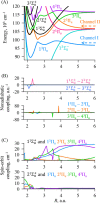Recombination of N Atoms in a Manifold of Electronic States Simulated by Time-Reversed Nonadiabatic Photodissociation Dynamics of N2
- PMID: 37166125
- PMCID: PMC10201567
- DOI: 10.1021/acs.jpclett.3c00666
Recombination of N Atoms in a Manifold of Electronic States Simulated by Time-Reversed Nonadiabatic Photodissociation Dynamics of N2
Abstract
Following a single photon VUV absorption, the N2 molecule dissociates into distinct channels leading to N atoms of different reactivities. The optically accessible singlets are bound, and dissociation occurs through spin-orbit induced transfer to the triplets. There is a forest of coupled electronic states, and we here aim to trace a path along the nonadiabatic couplings toward a particular exit channel. To achieve this, we apply a time-reversed quantum dynamical approach that corresponds to a dissociation running back. It begins with an atom-atom relative motion in a particular product channel. Starting with a Gaussian wave packet at the dissociation region of N2 and propagating it backward in time, one can see the population transferring among the triplets due to a strong nonadiabatic interaction between these states. Simultaneously, the optically active singlets get populated because of spin-orbit coupling to the triplets. Thus, backward propagation traces the nonradiative association of nitrogen atoms.
Conflict of interest statement
The authors declare no competing financial interest.
Figures




References
-
- Gilmore F. R. Potential Energy Curves for N2, NO, O2 and Corresponding Ions. J. Quant. Spectrosc. Radiat. Transfer 1965, 5, 369–389. 10.1016/0022-4073(65)90072-5. - DOI
-
- Lefebvre-Brion H.; Field R. W.. The Spectra and Dynamics of Diatomic Molecules; Elsevier: Amsterdam, 2004.
-
- Li X.; Heays A. N.; Visser R.; Ubachs W.; Lewis B. R.; Gibson S. T.; Van Dishoeck E. F. Photodissociation of Interstellar N2. Astron. Astrophys. 2013, 555, A14.10.1051/0004-6361/201220625. - DOI
-
- Li W.; Jaroń-Becker A. A.; Hogle C. W.; Sharma V.; Zhou X.; Becker A.; Kapteyn H. C.; Murnane M. M. Visualizing Electron Rearrangement in Space and Time during the Transition from a Molecule to Atoms. Proc. Natl. Acad. Sci. U. S. A. 2010, 107, 20219–20222. 10.1073/pnas.1014723107. - DOI - PMC - PubMed
-
- Rakitzis T. P.; Kandel S. A.; Zare R. N. Photolysis of ICl Causes Mass-Dependent Interference in the Cl(2P3/2) Photofragment Angular Momentum Distributions. J. Chem. Phys. 1998, 108, 8291–8294. 10.1063/1.476257. - DOI

